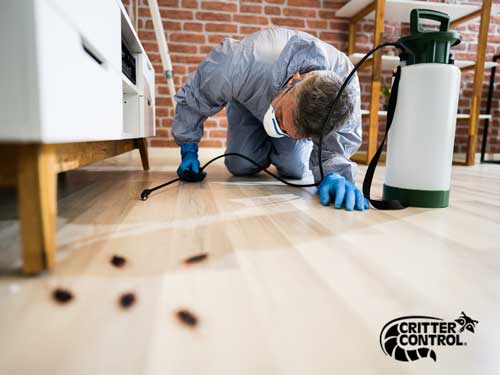Reliable A1 Bed Bug Treatment in Charlotte - Safe and Proven Approaches
Wiki Article
Bed Bug Therapy Breakdown: Contrasting Chemical Vs. Non-Chemical Solutions
In the realm of parasite control, especially when managing the persistent concern of bed pests, the choice between chemical and non-chemical therapy solutions can be a crucial one. Both strategies supply distinct advantages and disadvantages, influencing elements such as performance, safety factors to consider, and overall cost. By analyzing the nuanced details of each technique, a more clear understanding of which course to pursue in dealing with a bed insect problem can be attained.Efficiency of Chemical Treatments
Chemical therapies for bed bug infestations have been extensively identified for their potent and rapid efficacy in eradicating these parasites. When thinking about the effectiveness of chemical therapies, it is critical to understand that they can provide a fast and complete service to a bed bug trouble.Additionally, chemical therapies have the advantage of supplying residual impacts, meaning that they can remain to eliminate bed pests even after the first application. This recurring action is particularly advantageous in combating any type of potential re-infestations. In addition, the fast activity of chemical treatments can bring alleviation to individuals encountering serious bed pest invasions, permitting them to gain back control of their space swiftly.
Safety Interest In Chemical Solutions
One vital element that calls for careful consideration when utilizing chemical solutions for bed insect treatment is ensuring the security of residents and the atmosphere. Exposure to specific chemicals utilized in bed insect therapies can lead to respiratory concerns, skin inflammation, or various other adverse responses, particularly in individuals with pre-existing conditions or sensitivities.Furthermore, the environmental effect of chemical solutions is an additional substantial consideration. Some chemicals utilized in bed bug therapies might be unsafe to helpful bugs, wild animals, and communities if they seep into the soil or water supply. It is necessary to utilize chemical treatments deliberately, following safety and security guidelines, and considering much less harmful choices to mitigate these threats and make certain the effective and risk-free monitoring of bed bug infestations.
Benefits of Non-Chemical Techniques
Taking into consideration the possible security problems and ecological impact connected with chemical services for bed pest therapy, exploring non-chemical methods offers a promising choice with numerous distinct benefits. Non-chemical methods supply a safer choice for families, specifically those with pet dogs, youngsters, or individuals sensitive to severe chemicals. These strategies get rid of the dangers of direct exposure to hazardous materials, decreasing the potential for unfavorable health effects. Furthermore, non-chemical treatments are ecologically friendly, as they do not add to air or water pollution, making them a sustainable selection for bug control.Furthermore, non-chemical remedies can be reliable in targeting bed insects, consisting of hard-to-reach areas where chemical treatments may not permeate - A1 pest control charlotte nc bed bugs. Techniques such as warmth treatment, vacuuming, heavy steam cleaning, and mattress encasements supply comprehensive eradication without the usage go to these guys of unsafe chemicals.
Limitations of Non-Chemical Treatments

In addition, non-chemical treatments frequently call for multiple applications to accomplish effective removal. This can be time-consuming and might not constantly guarantee total elimination of all bed pests and their eggs, especially in hard-to-reach or hidden locations.
Moreover, the success of non-chemical treatments greatly counts on appropriate execution and thoroughness, which can be challenging for people without professional competence. Poor application of non-chemical methods may result in insufficient elimination, resulting in consistent infestations and the demand for extra therapies.
For that reason, while non-chemical treatments have their benefits, it is vital to acknowledge these constraints and consider i pest control them when determining the most efficient strategy for taking care of bed bug infestations.
Expense Comparison: Chemical Vs. Non-Chemical Options
Given the limitations associated with non-chemical therapies, an essential facet to assess in the context of bed insect administration is the price comparison in between chemical and non-chemical options. In comparison, non-chemical treatments like warm therapy or heavy steam can be extra costly, with prices ranging from $1,000 to $6,000 for a whole home. While the preliminary price of chemical treatments might appear reduced, several therapies may be needed to totally eradicate the invasion, possibly enhancing the total expense.Conclusion

Considering the potential safety issues and ecological impact associated with chemical services for bed insect treatment, checking out non-chemical approaches offers an encouraging choice with several unique advantages.Given the constraints associated with non-chemical treatments, an important facet to evaluate in the context of bed insect management is the price comparison in between chemical and non-chemical options. In contrast, non-chemical treatments like warm therapy or vapor can be much more costly, with expenses varying from $1,000 to $6,000 for a whole home. While the first cost of chemical treatments may seem reduced, numerous therapies might be required to fully get rid of the problem, potentially increasing the general expense.In conclusion, when contrasting chemical and non-chemical bed pest therapy alternatives, it is necessary to take into consideration performance, safety, benefits, limitations, and cost.
Report this wiki page